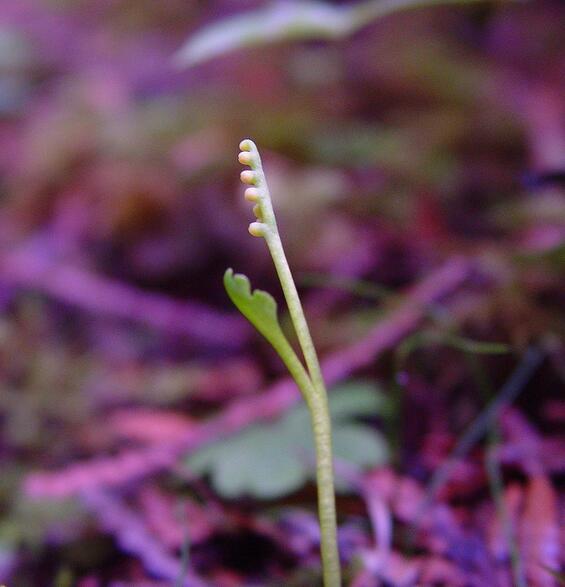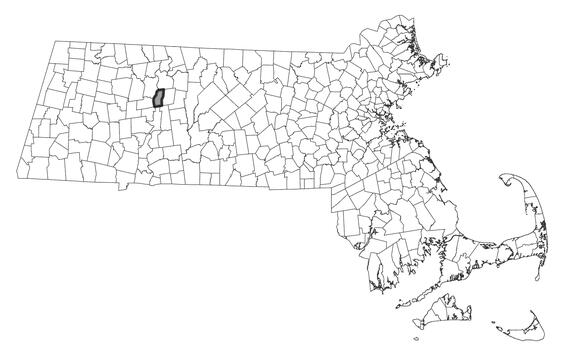- Scientific name: Botrychium tenebrosum A.A. Eat.
- Species of Greatest Conservation Need (MA State Wildlife Action Plan)
Description

Least moonwort (Botrychium tenebrosum). Photo by Arthur Haines, Native Plant Trust.
Swamp moonwort is a very small fern that grows in swampy mixed forests of deciduous and coniferous trees. It is best found at the end of June or early July. Stems come up individually and are at most 20 cm (8 in) in height. Our most recent collections describe the plant as bright green, yet other descriptions of the species allow for whitish-green to dull green. The above-ground portions of moonworts are divided into a stalk, a trophophore which looks the most leaf-like of the parts, and the sporophore which bears the spore bearing surfaces. The trophophore is up to 7 cm (~3 in) long with one to three pairs of leaflets, glabrous (without hairs) on both surfaces, and somewhat fleshy. The sporophore is about twice the length of the trophophore.
Swamp moonwort looks similar to, and is sometimes recognized as a variety of, least moonwort (Botrychium simplex). Least moonwort has a clearly larger and more intricate base pair of leaflets, whereas in swamp moonwort, the base pair is essentially the same as the pair above it. The trophophore is usually much higher on the stalk in swamp moonwort, above the midway point of the entire length of the above-ground portion of the plant. In least moonwort, the trophophore is often right at ground level, or only an inch above the ground, and below the halfway point of the entire length of the plant. The habitats are different as well; swamp moonwort is found in forested wetlands and least moonwort is found generally in open areas with full sun and sometimes in disturbed areas.
Life cycle and behavior
Moonworts are somewhat mysterious and do not appear above ground every year. Their cryptic nature makes them difficult to assess and to locate. They are diminutive in every way. They have very little leaf surface, the stem is narrow like a pipe cleaner, and the fruiting portion, as in all ferns, only has spore-bearing parts that are greenish.
Population status
Verified reports of swamp moonwort since 1999 are from Berkshire and Franklin Counties. Previous collections also included Essex and Norfolk Counties.
Distribution and abundance
This species is known to occur throughout New England, but there are few specific records, due in part to difficulties sorting this species out from least moonwort. Swamp moonwort also occurs in northern Europe.

Habitat
Swamp moonwort is found in swampy woods which are generally a mix of deciduous and coniferous trees. The most recent collections were in a hemlock-hardwood forest with patchy to sparse understory and dense leaf litter. Associated species include Fraxinus americana (white ash), F. nigra (black ash) Tsuga canadensis, (hemlock), Acer saccharum (sugar maple), Carpinus caroliniana (American hornbeam), Fagus grandifolia (beech), Lindera benzoin (spicebush), Symplocarpus foetidus (skunk cabbage), Osmunda cinnamomea (cinnamon fern), Thelypteris noveboracensis (New York fern), Botrychium virginianum (rattlesnake fern), Maianthemum canadense (Canada mayflower), Uvularia perfoliata (perfoliate bellwort), Polystichum acrostichoides (christmas fern), Eurybia divaricata (white wood-aster), Phegopteris hexagonoptera (broad beech fern), and P. connectilis (long beech fern).
Healthy habitats are vital for supporting native wildlife and plants. Explore habitats and learn about conservation and restoration in Massachusetts.
Threats
More research and data from recent surveys are needed to understand the threats to this rare species. Sixty percent of the members of this family, the Ophioglossaceae (the adder’s tongue family), have declined throughout the northern latitudes, including New England, the highest rate of all plant families. One theory is that many of the moonworts are dependent on a rich and thick leaf litter layer which has been degraded in many northern forests by non-native earthworms.
Conservation and management
Careful and thorough botanical inventory work will help with management decisions and should be a part of follow up to management work. More work should be done on correlations of the moonwort with earthworm populations and leaf litter.
References
Gleason, H.A., and A. Cronquist. 1991. Manual of Vascular Plants of Northeastern United States and Adjacent Canada. Second ed.. Bronx, NY: New York Botanical Garden.
Haines, A. 2011. New England Wild Flower Society's Flora Novae Angliae: A Manual for the Identification of Native and Naturalized Higher Vascular Plants of New England. Yale University Press.
New England Wild Flower Society. 2015. State of the Plants: Challenges and Opportunities for Conserving New England’s Native Flora. Framingham, MA.
Iowa State University Ada Hayden Herbarium moonwort (Botrychium) Systematics. URL: http://www.herbarium.iastate.edu/botrychium.html
Contact
| Date published: | April 8, 2025 |
|---|